Well, better late than never… let’s have a look at the July housing market data.
Prices
The size-adjusted median price was down for both property types, with condos experiencing whackage of 5.2% in July alone.
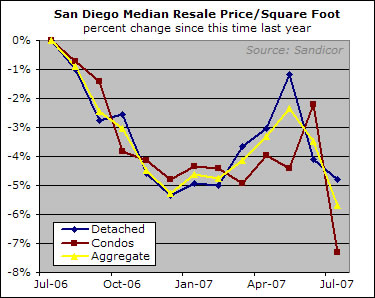
In aggregate, the size-adjusted median is now down 9.3% from the September 2005 peak in this data series:
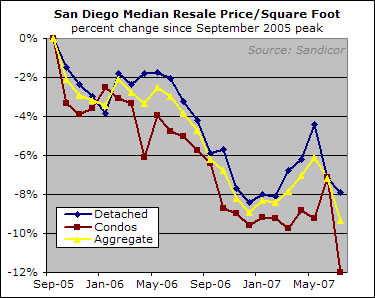
From the Department of Useless Statistics we get the latest plain-vanilla median numbers:

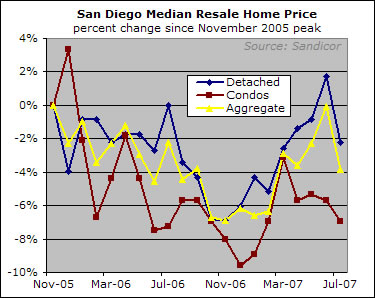
Until recently, the median and size-adjusted median prices had been trending up ever since the subprime problems began in late 2006, removing entry-level buyers from the market and giving a boost to the median-based price indicators. Now, the upward trend has gone into reverse.
Is the composition of home sales shifting back to normalcy, removing the post-subprime median boost?
Or, are higher-end homes still comprising a relatively high proportion of sales, but at a pace of price declines that is outstripping the post-subprime median boost?
Or, is this just monthly noise?
In the interesting of distracting you from the fact that I don’t know the answer, here’s another chart with colored lines:
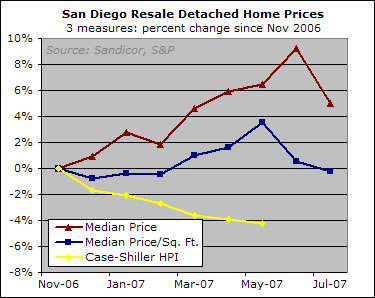
Oops, but that leads to yet another question. If the Case-Shiller HPI (which is the data series that most accurately represents price movements) was moving down while the median-based indicators were moving up, what does it mean that the median indicators are now moving down?
Supply and Demand
More of the same, for the most part. Inventory was slightly down from last year:
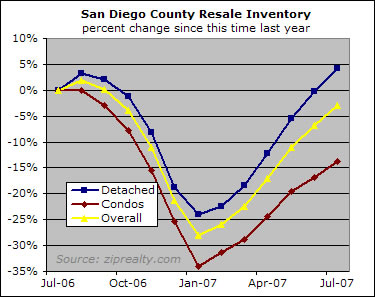
…while sales were down more:

…resulting in a months-of-supply figure of 8.1 months, 12.8% higher than this time last year.
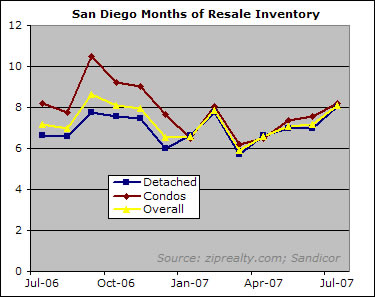
I continue to believe that "want to sell" inventory is less important than "must sell" inventory. On that front, we can see that things have deteriorated markedly since last year:
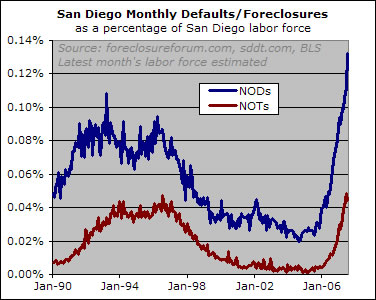
I’ve previously discussed the idea that NODs and NOTs might be double-counting defaulting homeowners due to the rampant use of piggybacks. My guess at the time (and it was just a guess, though a guess validated by my badass REO broker friend and occasional guest correspondent Ramsey) was that the second lien holders didn’t want to incur the cost when they had no chance of getting anything out of it, so there probably wasn’t significant double-counting. I’ve gotten my hands on some data that will allow me to do a more rigorous analysis soon, but a quick and dirty look suggests that the initial guess was correct. More on this issue later…
Conclusion
The most interesting thing about this month’s data was the noticable decline in the median-based indicators. It seems to me that the bulls have been able to cling to two highly related strands of data to support their case: the relative stability of the median price (which, while meaningless, can be used to mislead the ill-informed), and the solid demand and pricing power in the higher end areas (which has led them to scale the previous "San Diego is immune to home price declines" mantra back to "Del Mar | Carmel Valley | Encinitas | etc. is immune to home price declines.").
This month, anyway, the median-based price indicators didn’t play along. And looking forward, I expect the second rationalization to go up in smoke as well. Lending has suddenly gotten a lot tighter for buyers with good credit, and I think that will directly impact the high-end submarkets that have until now held up so well. Problems in the high-end markets will of course reverse the artificial upward bias we’ve seen in the median, so that bullish lifeline would disappear as well.
The tightening for creditworthy buyers has just taken place within the last couple of weeks. It does not show up in the data you see above, and it will only have begun to show up in next month’s data. The full impact of what’s happened to date will only be seen in the September data, and of course, by then we might have yet more tightening in the pipeline. Such is the nature of these lagged and backward-looking stats.
Anyway, the point is that what you see in the charts above is not the big news. The big news is that the last bastion of bullish optimism, the "desirable" submarkets, just had the financing rug pulled out from under it. The full effects won’t be felt until later in the year, and when they are, the legions of people who are still in denial about the nature and inevitable aftermath of the San Diego housing bubble may be in for a surprise.

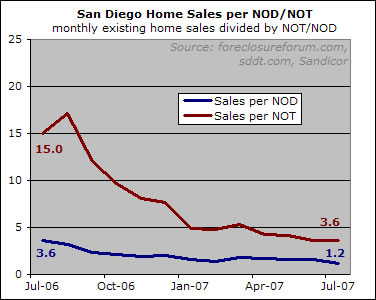
Good analysis.
To show you
Good analysis.
To show you the results of all of this info……………I spent a couple of hours this morning scouring sdookup.com at various areas around San Diego. What’s really interesting is that many of the pictures for the houses and condos that have been for sale for over 90 days……………are EMPTY. How long before these owners are going to get tired of carrying these properties and lower their prices to whatever level it will take to get an offer?
With all due respect, all
With all due respect, all charts and trend lines based on previous data are utterly meaningless at this point.
If Thornburg, an outfit that actually did its job properly during the boom (and has something like 53 delinquencies out of 35K+ jumbo loans,) if they can’t sell mortgages, no one can.
It’s a brand new ballgame.
What do we think about what
What do we think about what will happen at the upper end of the market (e.g. >1M homes) This index shows consistent price appreciation at the upper end.
Do we believe the underlying data?
Do we think it will last?
http://www.firstrepublic.com/lend/residential/prestigeindex/sandiego.html
Woodbury